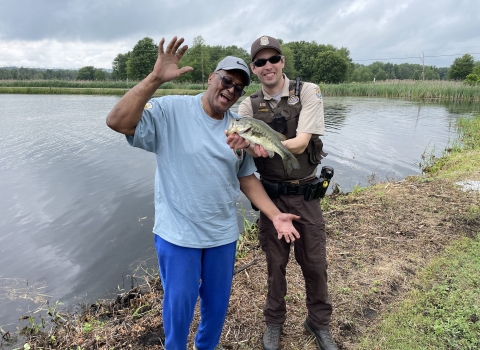What is the sickle darter?
The sickle darter is a small, bottom-dwelling fish native to the upper Tennessee River drainage in North Carolina, Tennessee and Virginia. Sickle darters are typically found in slow flowing pools of larger, upland creeks and small to medium rivers.
Where does the sickle darter occur?
Historically (prior to 2005), the sickle darter was known to be found in nine tributary systems of the upper Tennessee River drainage in the following rivers in North Carolina, Tennessee and Virginia: Emory, Clinch, Powell, Little, French Broad, North Fork Holston, Middle Fork Holston, South Fork Holston and Watauga. Currently, it is represented by six populations occupying portions of the Emory River system (Tennessee), the Upper Clinch River system (Virginia), the Little River system (Tennessee), the North Fork Holston River system (Virginia), the Middle Fork Holston River system (Virginia), and the Sequatchie River system (Tennessee – discovered in 2014). Populations within the French Broad River (North Carolina), South Fork Holston River (Tennessee), Powell River (Tennessee), and Watauga River systems (Tennessee) have been lost.
What action is the U.S. Fish and Wildlife Service taking?
The Service is finalizing a rule to list the sickle darter as a threatened species under the Endangered Species Act (ESA). The Service is also implementing a 4(d) rule that will tailor protections for the darter while allowing activities that do not harm its recovery.
What are the threats to the sickle darter?
Habitat loss and degradation from a variety of sources (dams and other barriers, resource extraction) and degraded water quality (chemical contamination and siltation from development, agriculture, mining, and timber operations) have been detrimental to the sickle darter. These threats, combined with the negative effects of the species’ reduced range and the effects of climate change climate change
Climate change includes both global warming driven by human-induced emissions of greenhouse gases and the resulting large-scale shifts in weather patterns. Though there have been previous periods of climatic change, since the mid-20th century humans have had an unprecedented impact on Earth's climate system and caused change on a global scale.
Learn more about climate change , have caused the disappearance of sickle darter populations in the French Broad River, South Fork Holston River, Powell River and Watauga River systems. The species’ only population within the Blue Ridge ecoregion of North Carolina (French Broad River system) has been eliminated.
Will the Service be designating critical habitat for the species?
To the maximum extent prudent and determinable, the Service must designate critical habitat for any species determined to be endangered or threatened under the ESA. Currently, the Service is only listing the species and implementing a 4(d) rule. The Service is in the process of determining critical habitat and a proposed critical habitat rule will follow publication of the listing rule.
What is a 4(d) rule? Why is this being put in place for the sickle darter?
For threatened species, the Service uses the flexibility provided under section 4(d) of the ESA to tailor the take prohibitions to those necessary and advisable for the conservation of the species.
This targeted approach helps reduce regulatory burdens by exempting certain activities that do not significantly harm the species, or that are beneficial, while focusing conservation efforts on the threats detrimental to recovery.
What protections and prohibitions do the 4(d) rule specify for the sickle darter?
The 4(d) rule for the sickle darter provides exceptions to incidental take resulting from the following: (1) State restoration and conservation actions, (2) channel restoration projects that create stable, ecologically functioning streams and that take place between April 1 and January 31; (2) streambank stabilization projects that take place between April 1 and January 31; (3) bridge and culvert replacement, and low-head dam removal projects that increase fish passage fish passage
Fish passage is the ability of fish or other aquatic species to move freely throughout their life to find food, reproduce, and complete their natural migration cycles. Millions of barriers to fish passage across the country are fragmenting habitat and leading to species declines. The U.S. Fish and Wildlife Service's National Fish Passage Program is working to reconnect watersheds to benefit both wildlife and people.
Learn more about fish passage and connectivity that take place between April 1 and January 31; and (4) silviculture and forest management activities that implement State-approved BMPs. The provisions in this rule for channel restoration and habitat protection can only occur between April 1 and January 31, to avoid the sickle darter’s spawning period.
The 4(d) rule being implemented was revised from its proposed form to include exceptions to prohibitions year-round (without exclusion during the spawning period) for silviculture and forestry actions that implement State-approved BMPs and removed the exception for conservation agencies since those actions are covered under section 6 cooperative agreements with North Carolina and Tennessee. The language of the rule was also revised to include State-approved BMPs and removed references to “highest standard” BMPs.
How can the public view information that was used in preparing the final rule listing the sickle darter as a threatened species?
This final rule is available on the Internet at http://www.regulations.gov. Comments and materials received, as well as some supporting documentation used in preparing this rule, are available for public inspection at http://www.regulations.gov. All of the comments, materials, and documentation that were considered in this rulemaking are available at http://www.regulations.gov at Docket No. FWS–R4–ES–2020–0094.
For further information contact: Daniel Elbert, Field Supervisor, U.S. Fish and Wildlife Service, Tennessee Ecological Services Field Office, 446 Neal Street, Cookeville, TN 38501; telephone 913–528–6481. Persons who use a telecommunications device for the deaf (TDD) may call the Federal Relay Service at 800–877–8339.
When will this rule become final?
The rule finalizing the listing and 4(d) rule for the sickle darter will become final on 12/08/2022.



